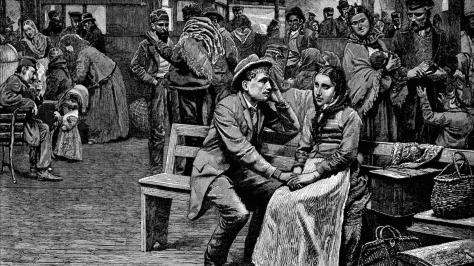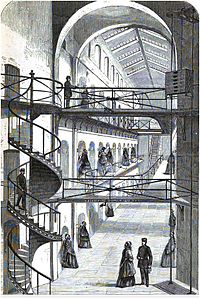
Mr Pass, like many fathers, wanted the best for his daughter. He was part of the large immigrant population of London, a boot maker by trade, he lived in Hoxton, East London. His sister had married and was living in Regent’s Park, well away from some of the bad influences Pass feared his daughter might be exposed to. So at an early age he opted to send her to live there.
It must have been a wrench but then again, with his wife dead Pass was hardly in a position to bring up his child and educate her to be the respectable Jewish woman he hoped she would become. Moreover, his sister, Louisa Salomens, was a ‘lady of property’, who had a house in Northumberland Terrace, and young Rebecca Pass would do well there.
So off she was sent as an infant to live and learn from her aunt. All was going well until one day in early July 1857 when Rebecca, accompanied by a servant bearing a note, turned up at Pass’ home in Hoxton. The message was worrying: according to Mrs Salomens Rebecca had ‘formed some improper connection’ with an unsuitable young man and Louisa felt it best that her brother now take ‘exclusive control’ of his daughter.
Pass must have been shocked and then angry but of course he took Rebecca in and made her as comfortable as possible. She lived there under strict supervision (probably never being allowed out, unless it was with her father) until the last week or so of the month when the Pass household had another unexpected visitor at their home in Pitfield Street, Hoxton.
This time it was a young man named John Aarons, a ‘swarthy, sun burnt’ fellow who gave his address as the Continental Hotel in Leadenhall Street. Aarons explained that there had been a terrible misunderstanding ‘arising from a trifling misconception’, and there really was no ‘unsuitable connection’ at all, Louisa had got it all wrong. He had come to accompany Rebecca back to Northumberland Terrace where her uncle was waiting to take a trip to the country. He was very keen to see Rebecca before he went.
Perhaps experiencing a mix of emotions the boot maker agreed to let Aarons take her away, but insisted he had her back by six that evening. With that his daughter walked off with the young man, supposedly on her way back to Regent’s Park, albeit temporarily.
Of course, she never arrived. Pass travelled to his sister’s when she failed to appear and the police were immediately informed. A description of Aarons was circulated and he was soon picked up by a City of London constable in Houndsditch. On Monday morning (27 July) Aarions was brought before Mr Hammill at Worship Street, charged with abduction.
Both Pass and his sister were in court to set the scene. Louisa Salomens (a ‘very lady-like person’), explained that her niece had become involved with a ‘man of loose morals and inferior station’ (I’m not sure which was worse really). In this she had been aided and abetted by one of Mrs Salomens servants, who had since been dismissed. Aarons had then turned up at her door and said he represented the young man that Rebecca had fallen for. He pleased for his friend and for Mrs Salomens to allow him to see Rebecca. The couple were in love he insisted, and it would ‘be a shame’ to part them.
Clearly Louisa wanted nothing to do with him and sent him away with a flea in his ear. So she was shocked to discover that he ‘had beguiled the girl from her father’s protection’ claiming he’d been sent by her. She’d sent no such message at all.
Aarons, demonstrating ‘an air of confident bravado’, tried gamely to cross-examine Mrs Salomens and her brother to undermine her testimony but both were steadfast and he failed. Mr Hammill said the charge of abduction had been clearly established and he would remand him in custody for a week while he decided what to do with him.
‘You don’t mean that!’ cried the prisoner from the dock. ‘Why I have paid my passage-money for America, and the ship sails tomorrow. But you’ll take bail, of course’.
No, Mr Hammill told him, he would not. Not at present, at least. This blow landed on Aarons but he soon recovered his ‘audacious demeanor’, and ‘swaggered out with the gaoler’.
Unusually for these little vignettes from the Police Courts this story has a happy ending.
Three days later a representative from a firm of London solicitors, Solomens, appeared in court to make a statement to Mr Hammill. They came to say that the young man who was at the heart of this love triangle had been found. He was not at all unsuitable or a person of ‘loose morals’ but instead was ‘respectably connected, and altogether unexceptionable in his character and circumstances’. Moreover, he had pledged to marry Rebecca immediately and thus, her ‘fair name remains unsullied’. As the family socilitor he was asking the court to discharge John Aarons forthwith.
The defendant was then brought over from the house of correction and the happy news was relayed to him. He was then released and Mr Hammill commented that he was delighted that all had ended as well as it had. Aarons had presumably still missed his boat though, but perhaps a grateful family might now be prepared to fund a ticket for a later one.
So, what do we think really happened here? Had Rebecca and her unnamed admirer become lovers? Was that why the aunt had become so concerned? Or had they simply been discovered together (in her room perhaps) without a chaperone? Who knows, at least all’s well that ends well as the bard would say.
[from The Standard, Monday, July 27, 1857; The Standard, Thursday, July 31, 1857]








